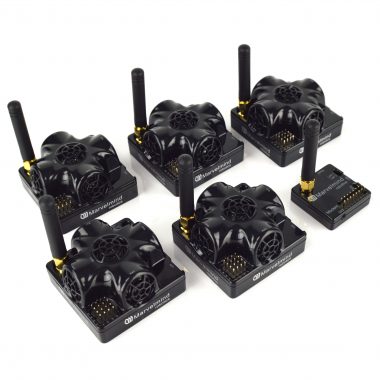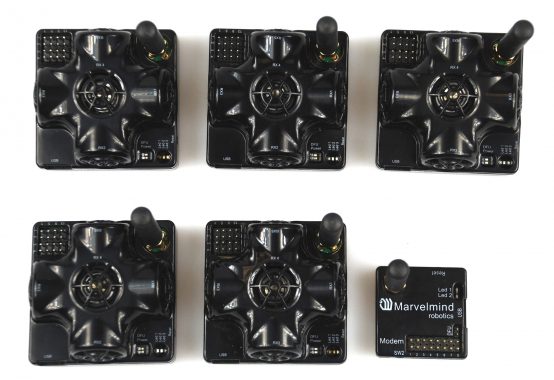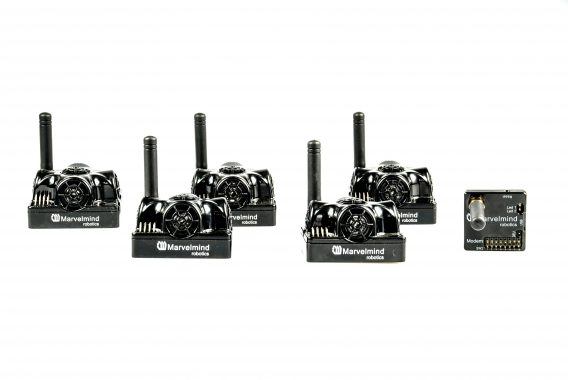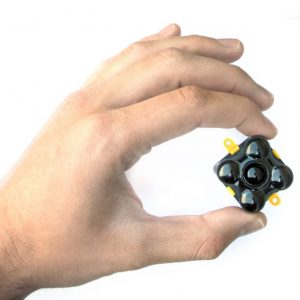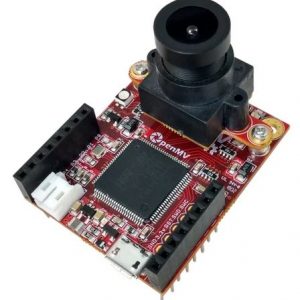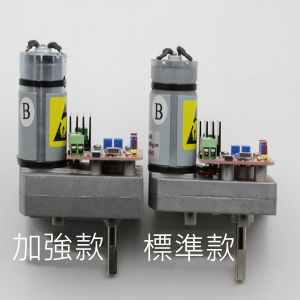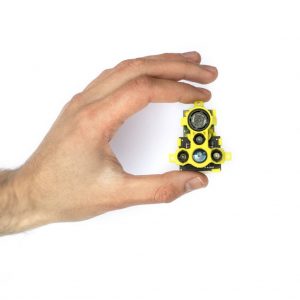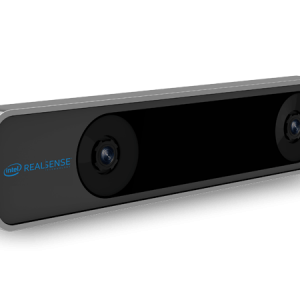Description
商品說明 :
- IA (Inverse Architecture)
- Stationary beacons(固定點) 彼此的發射頻率須是不相同的 (頻率選擇包括19, 25, 31, 37, 45 kHz)
- 位置更新速度與mobile beacons (移動點)的數量沒有直接關係
- 移動點安裝在較吵的機器人環境上,固定點beacons安裝在相對安靜的場所
- 安裝在移動的人或機器上,通訊透過 virtual COM (USB port)
- Indoor localization 系統最低組成需要 2個(或以上)固定點 + 1個(或以上)Mini-Rx Beacons + 1個中央路由器
- 最多可用250個beacons,每個beacons涵蓋範圍 30 ~ 50 米
- 可應用在不同區域與不同地圖的建置
- 價格便宜安裝迅速的機器人定位方法
- NIA (Non-Inverse Architecture)
- Stationary beacons(固定點) 彼此的發射頻率須是相同的
- 位置更新速度與mobile beacons (移動點)的數量有關係 (25Hz更新速度)
- 移動點安裝在較安靜的機器或人環境上,固定點beacons安裝在相對較吵的場所
- 安裝在移動的人或機器上,通訊透過 SPI, I2C, USB
- Indoor localization 系統最低組成需要 2個(或以上)固定點 + 1個(或以上)Mini-Rx Beacons + 1個中央路由器
- 最多可用250個beacons,每個beacons涵蓋範圍 30 ~ 50 米
- 可應用在不同區域與不同地圖的建置
- 價格便宜安裝迅速的機器人定位方法
- 還是看不懂,正常 ! 沒關係,看一下這裡,更詳細扼要地介紹IA , NIA, MF NIA 的架構與比較
- 所謂的3D就是 (x,y,z)立體空間的定位,2D就是(x,y)平面的定位測量。簡單說,只要一個(or以上) beacon放在Z軸方向上,就可形成3D定位。
- 各種應用介紹 (工廠與作業場所安全,定位系統,建築工地安全、隧道安全與人員定位,智慧安全防護帽/智慧安全背心/智慧徽章/搬運機器人),下載這個25頁的投影片
- 2D / 3D 定位,mobile beacons 移動點與stationary beacons 固定點的擺設方法,參考這裡
- 看一下這裡,更詳細扼要地介紹IA , NIA, MF NIA 的架構與比較
- 無人機/Pixhawk 與 marvelmind的架設安裝方法,參考這裡
- 室內定位詳細手冊與理論,參考這裡
- 所有軟體都免費,參考這裡
- Live demo: Delivering boxes on a car assembly plant
- Live demo: Delivering boxes on a car assembly plant – system view
- Live demo: Don’t-Try-This-At-Home fun edition 😉
內容物 :
- 4 Stationary beacons with standard 50mm antennas
- 1 Mobile beacon without IMU
- 1 Modem supporting up to 250 beacons
The Starter Set Super-NIA-3D is based on Super-Beacons.
Super-Beacons are a newer version of Beacons HW v4.9 and superior to them in nearly all aspects:
- Super-Beacons have sharp DSP filters (like Mini-RX or Industrial-RX). The Super-Beacons are more sensitive and more interference resistant than Beacons HW v4.9 that are based on analogue filters
- Super-Beacons have improved TX part and power-saving features that allows up to 10x battery lifetime improvement over Beacons HW v4.9 (depending on the settings and update rate)
- Super-Beacons, like Mini-RX and Industrial-RX, use a single wide-beam microphone for receiving ultrasound, thus making submaps in complex conditions (larger distances, for example, or noisy environment) much easier to build, than that with Beacons HW v4.9, because the microphone is always on and it has a wide reception diagram. Whereas, with Beacons HW v4.9 in those challenging conditions, one would need to turn off some sensors and, generally speaking, taking care about the number of sensors (RX1-RX5) turned on in order to provide proper coverage, on the one hand, and to maintain the right sensitivity on another
- All Super-Beacons have 6D IMU (3D accelerometer and 3D gyroscope)
Super-Beacons are better than Mini-RX and Mini-TX as well:
- Super-Beacons are dual-use: they can both receive and transmit ultrasound. You can absolutely freely to use them as stationary and as mobile
- Super-Beacons have external pins (UART, SPI, reset, etc.)
- Super-Beacons have external antenna for longer radio range and larger maps
Super-Beacons support both IA and NIA. Notice, that the set is purely NIA, i.e. all ultrasonic transducers are on the same frequency 31kHz. But you can purchase additional Super-Beacons on other ultrasonic frequencies (19kHz, 25kHz, 37kHz, 45kHz) and re-use earlier purchased 31kHz Super-Beacons and to build IA systems.
Content:
- 4 Stationary Super-Beacons
- 1 Mobile Super-Beacon
- 1 Modem supporting up to 250 beacons
All beacons (stationary and mobile) are equipped with with 6D IMU (3D accelerometer + 3D gyroscope) and standard 50mm antennas. Effectively, you are getting 5 absolutely similar Super-Beacons
The HW of the system supports two bands:
- License-free ISM band (915 MHz) for the US and countries in Region 2 (https://en.wikipedia.org/wiki/ITU_Region)
- License-free SRD band (868 MHz) for the EU and other countries: (https://en.wikipedia.org/wiki/Short-range_device#SRD860)
We always recommend to check your country’s local regulations.
Marvelmind Indoor Navigation System is off-the-shelf indoor navigation system designed to provide precise (±2cm) location data to autonomous robots, vehicles (AGV), and copters. It can also be used to track other objects with a mobile beacon installed on them, for example, forklifts in warehouses or virtual reality (VR) helmets or helmets for construction workers or miners, etc.
The navigation system is based on stationary ultrasonic beacons united by radio interface in a license-free band (915/868 MHz ). The location of a mobile beacon is calculated based on the propagation delay of an ultrasonic signal (Time-Of-Flight or TOF) to a set of stationary ultrasonic beacons using trilateration. No manual calibration is required. No need to know exact locations of the beacons – the system builds the map of beacons automatically.
The set contains a mobile beacon with IMU that gives a possibility for ultrasonic + IMU (3D accelerometer + 3D gyro) fusion. That allows much faster update rate – up to 100Hz and above.
系統正常運作的主要條件 :
- For 3D (X, Y, Z) tracking – An unobstructed sight by a mobile beacon of three or more stationary beacons simultaneously
- For 2D (X, Y) tracking – An unobstructed sight by a mobile beacon of two stationary or more stationary beacons simultaneously
- Distance to the nearest 2 or 3 beacons – not more than 30 meters (recommended). In ideal conditions – up to 50 meters
技術規格 :
Distance between beacons
- Reach up to 50 meters in lab conditions (Transducer4 to microphone looking straight at each other)
- Recommended distance is 30 meters (Transducer4 to microphone looking straight at each other)
Coverage area
- Reach up to 1000 m2 with the Starter Set configurations
- Coverage for larger territories is similar to cellular networks
Location precision
- Absolute: 1–3% of the distance to the beacons
- Differential precision: ±2 cm
Location update rate
- 0.05–25Hz
- Can be set manually
- Depends on the distance between the mobile and stationary beacons (shorter distance — higher update rate)
- Depends on the number of mobile beacons: for example, update rate of 25Hz for 1 mobile beacon will result in update rate of 25Hz/2 for 2 mobile beacons, and 25Hz/3 – for 3 mobile beacons, etc
- Depends on the radio interface profile (500kbps vs. 38kbps)
- Slightly depends on the number of stationary beacons—different than for mobile beacons
Power supply
Internal:
- LiPol battery 1000mAh
- Battery lifetime depends on many parameters. Mostly:
- Mode – transmitting or receiving
- Location update rate – faster update rate – nearly, proportionally shorter battery life-time)
- Radio profile – 500kbps better than 38kbps, because shorter
- Submap size or limitation of distance – shorter distance => longer battery life-time
- Examples:
- Receiving beacon 8Hz update rate and 10m submaps => up to 65h (tested)
- Transmitting beacon 8Hz update rate => up to 130h (tested)
- Receiving beacon 1/10Hz update rate and 10m submaps => more than 500h (tested)
- Transmitting beacon 1/10Hz update rate => more than 500h (tested)
External:
- microUSB – recommended for permanent use
Weight
Mobile beacon from Starter Set:
- 59 grams (including battery 1000mAh and housing and antenna 50mm)
- 27 grams (bare board w/o battery)
Beacon size
- 55x55x33 mm (with 50mm antenna: 55x55x65mm)

